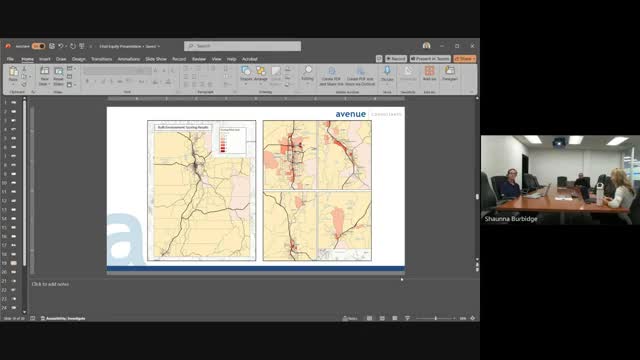Mapping Vulnerable Communities Uncovers Impact of Redlining
October 13, 2024 | Utah Department of Transportation, Utah Government Divisions, Utah Legislative Branch, Utah
This article was created by AI summarizing key points discussed. AI makes mistakes, so for full details and context, please refer to the video of the full meeting. Please report any errors so we can fix them. Report an error »

In a recent government meeting, officials presented a detailed analysis of urban vulnerability and built environment concerns across various regions, particularly focusing on Salt Lake City and surrounding areas. The discussion highlighted a mapping initiative that identifies neighborhoods with significant socio-economic vulnerabilities, overlaying these with built environment issues.
The analysis revealed that while Salt Lake City had only one area with nine identified concerns, many urbanized regions exhibited clusters of four or more issues. The mapping utilized a color-coded system to indicate the severity of vulnerabilities: areas with high social vulnerability index (SVI) were marked in orange, those with built environment concerns in salmon pink, and regions facing both challenges were highlighted in red.
Key areas of concern were identified in the Salt Lake Valley, particularly around downtown and West Valley, as well as pockets in Utah County and Ogden. The findings suggest that these clusters could benefit from targeted interventions to address both social and environmental challenges.
Officials emphasized the importance of understanding the underlying factors contributing to these vulnerabilities, noting that historical redlining played a significant role in shaping the current landscape. This deeper analysis aims to inform future policy decisions and resource allocation to effectively address the needs of these vulnerable communities. The meeting underscored a commitment to using data-driven approaches to enhance urban resilience and improve living conditions for affected populations.
The analysis revealed that while Salt Lake City had only one area with nine identified concerns, many urbanized regions exhibited clusters of four or more issues. The mapping utilized a color-coded system to indicate the severity of vulnerabilities: areas with high social vulnerability index (SVI) were marked in orange, those with built environment concerns in salmon pink, and regions facing both challenges were highlighted in red.
Key areas of concern were identified in the Salt Lake Valley, particularly around downtown and West Valley, as well as pockets in Utah County and Ogden. The findings suggest that these clusters could benefit from targeted interventions to address both social and environmental challenges.
Officials emphasized the importance of understanding the underlying factors contributing to these vulnerabilities, noting that historical redlining played a significant role in shaping the current landscape. This deeper analysis aims to inform future policy decisions and resource allocation to effectively address the needs of these vulnerable communities. The meeting underscored a commitment to using data-driven approaches to enhance urban resilience and improve living conditions for affected populations.
View full meeting
This article is based on a recent meeting—watch the full video and explore the complete transcript for deeper insights into the discussion.
View full meeting

